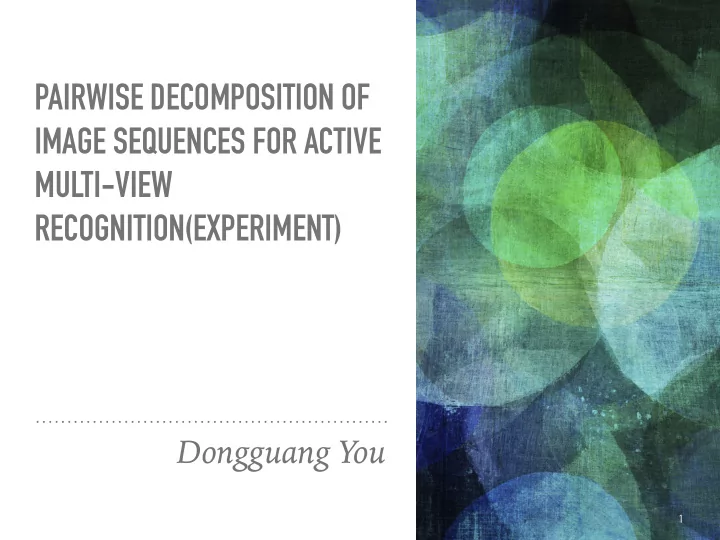

PAIRWISE DECOMPOSITION OF IMAGE SEQUENCES FOR ACTIVE MULTI-VIEW RECOGNITION(EXPERIMENT) Dongguang You 1
RECAP ➤ Pairwise Classification 2
RECAP ➤ Pairwise Classification ➤ Next Best View selection/Trajectory Optimisation 3
TRAJECTORY OPTIMISATION ➤ Goal: maximize X predictedCrossEntropy ( i, j ) i,j ∈ Sequence ➤ At each step: find a trajectory that maximizes X predictedCrossEntropy ( i, j ) i ∈ Observed,j ∈ unobserved 4
MOTIVATION ➤ Recall lambda in ➤ lambda only depends on the relative pose Failure case: ➤ Predicted cross entropy of pairs in two trajectories: [1, 10, 1] and [3, 3, 3] ➤ Choose [1, 10, 1] over [3, 3, 3] ➤ Lambda for the three pairs in [1, 10, 1]: 0.4, 0.2, 0.4 ➤ Sadly a small weight is assigned to the critical pair during classification 5
Failure case V1 lambda = 0.4 lambda = 0.4 predicted cross entropy = 1 predicted cross entropy = 1 lambda = 0.2 predicted cross entropy = 10 V2 V3 6
MOTIVATION ➤ Problem: lambda and predicted cross entropy may conflict ➤ Solution1: incorporate lambda into trajectory optimisation X λ ( i, j ) ∗ predictedCrossEntropy ( i, j ) i ∈ Observed,j ∈ unobserved ➤ choose [3,3,3] over [1,10,1] given lambda = [0.4,0.2,0.4] 7
V1 lambda = 0.4 lambda = 0.4 predicted cross entropy = 1 predicted cross entropy = 1 predicted cross entropy = 10 lambda = 0.2 V2 V3 X λ ( i, j ) ∗ predictedCrossEntropy ( i, j ) i ∈ Observed,j ∈ unobserved 8
MOTIVATION ➤ Problem: lambda and predicted cross entropy conflict ➤ Solution2: replace lambda with predicted cross entropy i = N X f ( y | w 1 ...w N ) = predictedCE ( w i ) ∗ p ( y | w i ) i =1 ➤ choose [1,10,1] over [3,3,3], and assign a weight = [1,10,1]/12 to the 3 pairs 9
V1 lambda = 0.4 lambda = 0.4 predicted cross entropy = 1 predicted cross entropy = 1 predicted cross entropy = 10 lambda = 0.2 V2 V3 i = N X f ( y | w 1 ...w N ) = predictedCE ( w i ) ∗ p ( y | w i ) i =1 10
EXPERIMENT SETUP ➤ Simplified setting ➤ binary classification ➤ relative poses are either good or bad ➤ consider testing data of one label ➤ Simulate the activation of the pairwise classification net ➤ assuming the activation follows Gaussian distribution 11
ACTIVATION SIMULATION Simulated Activation of True label Simulated Activation of False label 12
Good relative pose For True label: Gaussian(10, 0.5) Good For False label: Gaussian(0, 0.5) 13
Bad relative pose For True label: Gaussian(0.5, 0.5) bad For False label: Gaussian(0, 0.5) 14
RELATIVE POSE SIMULATION For each test sample ➤ 4*4 grids of viewpoints ➤ 120 pairs ➤ 60 pairs in good relative pose, 60 pairs in bad relative pose 15
CROSS ENTROPY PREDICTION SIMULATION ➤ Compute ground-truth cross entropy for each pair ➤ Predicted cross entropy ~ Gaussian(truth cross entropy, 0.5) 16
CONVERTING LAMBDA AND CROSS ENTROPY ➤ lambda and cross entropy are negative The author didn’t make this clear. He pick the pairs that are good by maximising the cross-entropy, so I assume he is using sum(p(x) * log(p’(x))), which is nonpositive ➤ converted lambda = lambda - min(lambda) - max(lambda) ➤ [-1.5, -1] -> [1, 1.5] ➤ [-2, -1.2 , -0.6] -> [0.6, 1.4, 2] ➤ Same for cross entropy 17
EXPERIMENT 1 ➤ Proposed: incorporate lambda into trajectory optimisation X λ ( i, j ) ∗ predictedCrossEntropy ( i, j ) i ∈ Observed,j ∈ unobserved ➤ Baselines: X predictedCrossEntropy ( i, j ) i ∈ Observed,j ∈ unobserved ➤ Baseline 1: averaged classification ➤ Baseline 2: classification weighted with lambda 18
RESULT1 average softmax across 1000 samples Baseline1: classification on average Baseline2: classification weighted with lambdas Proposed: Baseline2 + trajectory optimisation with lambdas 0.89 0.902 0.914 0.926 0.938 0.95 19
EXPERIMENT2 ➤ Proposed: use the predicted cross entropy as the weight, instead of lambda i = N X f ( y | w 1 ...w N ) = predictedCE ( w i ) ∗ p ( y | w i ) i =1 ➤ Baseline 1: averaged classification result ➤ Baseline 2: classification result weighted with lambda ➤ Baseline 3: classification result weighted with ground truth cross entropy 20
RESULT2 average softmax across 1000 samples Baseline1: classification on average Baseline2: classification weighted with lambdas Baseline3: classification weighted with ground truth cross entropy Proposed: classification weighted with predicted cross entropy 0.89 0.9 0.91 0.92 0.93 0.94 21
EXPERIMENT2* ➤ What if the effect of relative pose is weaker? The activation of correct label is modified: ➤ Good relative pose ~ Gaussian(1, 0.5) instead of Gaussian(10, 0.5) ➤ Bad relative pose ~ Gaussian(0.5,0.5), same as before ➤ What would the comparisons look like? 22
RESULT2* average softmax across 1000 samples Baseline1: classification on average Baseline2: classification weighted with lambdas Baseline3: classification weighted with ground truth cross entropy Proposed: classification weighted with predicted cross entropy 0.72 0.728 0.736 0.744 0.752 0.76 23
LIMITATION OF THE PAIRWISE METHOD ➤ do not have a global view(as compared to “Look ahead before you leap”) ➤ range of entropy is (-inf, 0), hard to guarantee the accuracy of regression 24
CONCLUSION ➤ When the effect of relative pose is strong ➤ incorporating lambda into trajectory optimisation might improve the prediction ➤ When the effect of relative pose is weak ➤ predicted cross entropy could be a better choice for weight than lambda 25
Recommend
More recommend